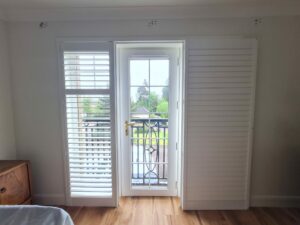Enhancing Your Home’s Noise Insulation with Noise Reducing Shutters

In this blog, we’ll explore the noise reduction capabilities of different types of shutters and how combining shutters with additional shading solutions can further improve your home’s sound insulation.
Understanding Noise Reduction with Louvered Shutters
Louvred noise reducing shutters can help reduce noise by creating an additional barrier to sound waves. On average, well-fitted louvred shutters can reduce noise levels by about 10 to 20 decibels (dB). Several factors influence this reduction:
- Material: Heavier, denser materials typically offer better sound insulation. Wooden shutters, especially those made from hardwoods, reduce noise more than lighter materials.
- Fit: Shutters that fit snugly within the window frame offer better sound insulation. Any gaps can allow sound to pass through more easily.
- Window Quality: The type and quality of the window itself also play a significant role. Double-glazed windows combined with shutters generally perform better in noise reduction than single-glazed windows.
- Room Acoustics: The overall acoustics of the room, including other furnishings and wall insulation, can affect the noticeable noise reduction.
The Impact of Sound Frequency
The effectiveness of louvred shutters in reducing noise can vary depending on the frequency of the sound:
- Low-Frequency Sounds (e.g., Traffic Noise): Low-frequency sounds, such as those from traffic, are generally more challenging to block because they have longer wavelengths that can penetrate most materials more easily.
While noise reducing louvred shutters can provide some reduction, they are typically less effective against low-frequency noise than high-frequency sounds.
Combining shutters with other soundproofing measures, such as heavy curtains, shutter-and-shade, or additional window glazing, can be more effective in mitigating low-frequency noise.
Mid to High-Frequency Sounds (e.g., Conversations, High-Pitched Noises): Louvered shutters reduce mid to high-frequency sounds more effectively. These higher-frequency sounds have shorter wavelengths, which are more easily absorbed and reflected by the materials used in shutters. Therefore, you may notice a more significant reduction in these types of noises.
Solid Shutters: A More Robust Solution
Solid shutters, compared to louvred shutters, generally offer better sound insulation:
- Material and Density: Solid shutters are usually made from heavier and denser materials, providing a more substantial barrier against sound waves.
- No Gaps: Unlike louvred shutters, solid shutters don’t have slats or gaps through which sound can pass, resulting in more effective noise reduction.
- Average Reduction: Solid shutters can typically reduce noise levels by 20 to 30 decibels (dB), which is higher than the 10 to 20 dB reduction from louvred shutters.
The Ultimate Combination: Shutter-and-Shade
Combining shutters with an insulating cellular blind behind them (a “Shutter and Shade” combination) can further enhance noise reduction:
- Additional Layer: The cellular blind adds an extra layer of material, enhancing the overall thickness and density of the window covering.
- Insulation: Cellular blinds, also known as honeycomb shades, have a design that traps air within their cells, providing excellent insulation properties. This trapped air acts as a buffer that can help absorb and reduce sound.
- Frequency Effectiveness: This combination is particularly effective at reducing both low and high-frequency sounds. The solid shutter blocks much of the direct noise, while the cellular blind absorbs additional sound energy.
Overall Noise Reduction:
- Solid Shutters Alone: Approximately 20 to 30 dB reduction, effective across a range of frequencies but particularly beneficial for higher frequencies.
- Shutter and Shade Combination: This combination can achieve a noise reduction of up to 35 to 40 dB, offering superior performance across all frequencies, including low-frequency noises like traffic.
Conclusion
Solid shutters will significantly enhance noise reduction compared to louvred shutters, particularly for higher frequencies. However, the best sound insulation performance is achieved with a Shutter-and-Shade combination. This setup provides a layered barrier that effectively reduces noise across the frequency spectrum, making it an excellent choice for environments with substantial noise pollution.
Caveat: These are average values; actual results depend on individual circumstances. A professional assessment is recommended for precise measurements and tailored advice.
You can arrange an appointment with one of our experts by calling 0800 086 2989. Our showrooms are open by appointment only to ensure our clients receive the complete and undivided attention of an expert.
We also offer home and virtual appointments to cater to your specific needs.
February 2024
The Scottish Shutter Company
S:Craft – Shutter & Shade
Noise Reducing Shutters
Noise Reducing Shutters
Noise Reducing Shutters
Noise Reducing Shutters
Noise Reducing Shutters
Noise Reducing Shutters







